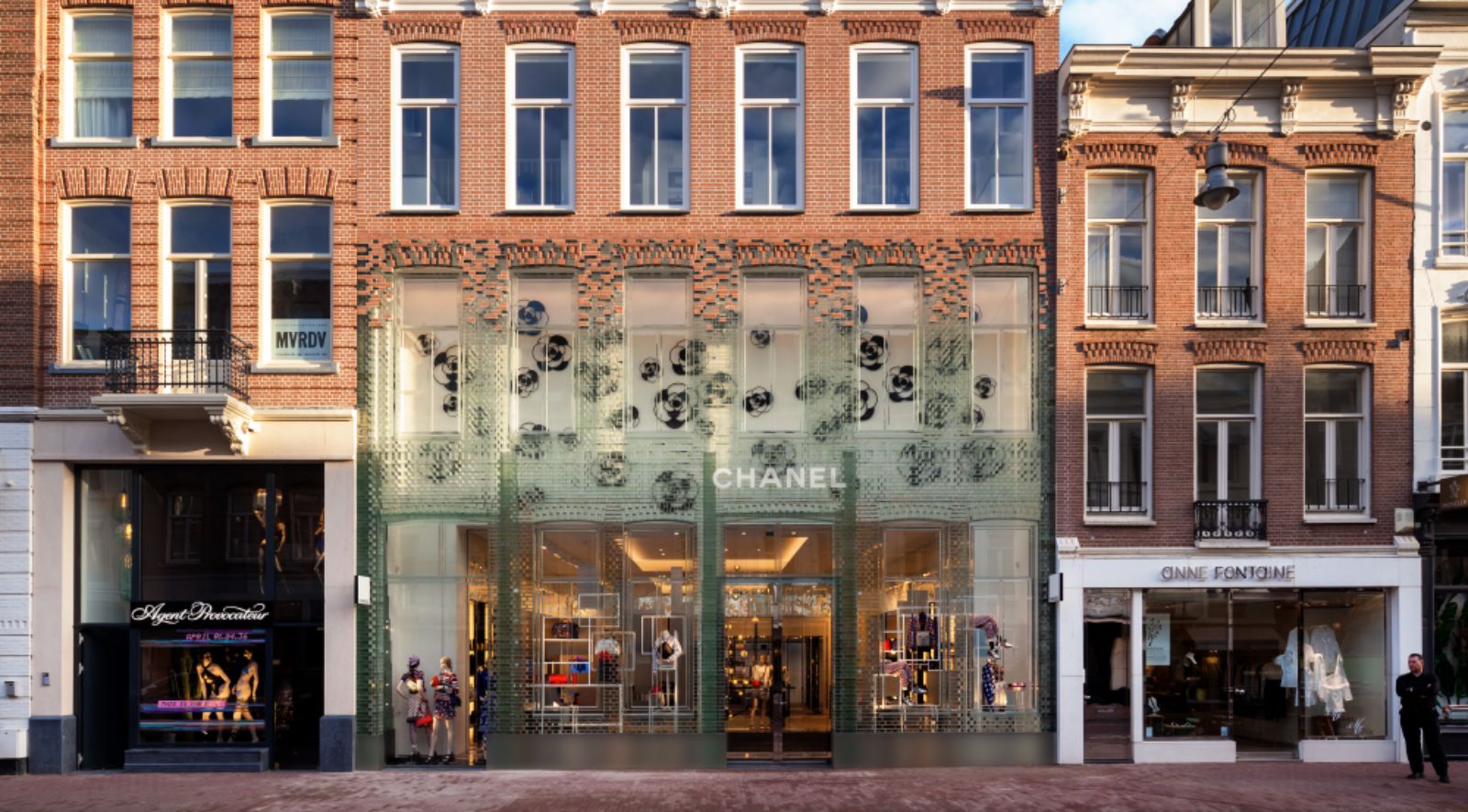The glass doors of Crystal Houses opened, a visionary exploration into reimagining the possible uses of glass in construction. The entirely transparent façade of a high-end flagship store on Amsterdam’s upmarket shopping street, PC Hooftstraat, uses glass bricks, glass windows frames and glass architraves in a way to evoke the vernacular of the area with the goal to maintain the character of the site. The 620 m2 of retail and 220 m2 of housing, were designed for investor Warenar. The design unites the ambition of Amsterdam to have large distinctive flagship stores without compromising the historical ensemble.
MVRDV’s Crystal Houses began its existence with the request of Warenar to design a flagship store combining both Dutch heritage and international architecture on the PC Hooftstraat, Amsterdam’s one and only luxury brand street that was previously primarily residential. MVRDV wanted to make a representation of the original buildings and found a solution through an extensive use of glass. The near full-glass façade mimics the original design, down to the layering of the bricks and the details of the window frames, but is stretched vertically to comply with updated zoning laws and to allow for an increase in interior space.
Glass bricks stretch up the façade of Crystal Houses, eventually dissolving into a traditional terracotta brick façade for the apartments (as stipulated in the City’s aesthetics rules), which appears to be floating above the shop floor. The design hopes to provide a solution to the loss of local character in shopping areas around the world. The increased globalisation of retail has led to the homogenisation of high-end shopping streets. Crystal Houses offer the store a window surface that contemporary stores need, whilst maintaining architectural character and individuality, resulting in a flagship store that hopes to stand out amongst the rest.
After conceiving the initial idea MVRDV worked closely with a number of partners to develop the technologies to make it possible. Solid glass bricks were individually cast and crafted by Poesia in Resana, near Venice. Research undertaken by the Delft University of Technology, in partnership with engineering firm ABT and contractor Wessels Zeist, led to the development of structural solutions and fabrication techniques, with the use of a high-strength, UV bonded, transparent adhesive from Delo Industrial Adhesives in Germany to cement the bricks together without the need for a more traditional mortar.
Six to ten experts worked every day for a whole year in a place that bore more resemblance to a laboratory than a construction site. Due to the sensitivity of the materials, an extremely high level of accuracy and craftsmanship was required and a technical development team was onsite throughout the process. Since this construction is the first of its kind, new construction methods and tools had to be utilised: from high-tech lasers and laboratory grade UV-lamps, to slightly lower-tech Dutch full-fat milk, which, with its low transparency, proved to be an ideal liquid to function as a reflective surface for the levelling of the first layer of bricks.
Despite its delicate looks, strength tests by the Delft University of Technology team proved that the glass-construction was in many ways stronger than concrete. The full-glass architrave, for instance, could withstand a force of up to 42.000 Newton; the equivalent to two full-sized SUVs. The development of new construction methods unearthed additional possibilities for future building, such as the minimisation of waste materials. In essence, all of the glass components are completely recyclable. Waste materials from the project, such as imperfect bricks, could simply be (and were) melted down and re-moulded or entirely repurposed.
Such is also true for the entire façade itself, once the building has reached the end of its life span, the whole facade can be melted down and given a new life. The only exceptions to this rule are added features which ensure the security of the building, such as a concrete ram-raid defence plinth, hidden in a blend of reflective and translucent materials and built to withstand the force of a car crashing into the building. Repair-protocols were developed in the event of any damage, allowing for the replacement of individual bricks.
With a façade made primarily out of glass it was important to ensure that energy requirements were supplied through renewable sources. Therefore, the building was designed around a ground source heat pump, its pipes leading up to 170 metres underground, allowing for an optimal indoor climate throughout the year. A crucial element when dealing with delicate, sophisticated detailing while striving for a proper energy balance at the same time. The store is currently operated by French fashion house Chanel which will return later to their previous location on the PC Hooftstraat, also owned by Warenar. Source by MVRDV.
Location: Amsterdam, Netherlands
Architects: MVRDV, Gietermans & Van Dijk Architects
Role of MVRDV: Lead Architect
Project Team MVRDV: Winy Maas, Gijs Rikken, Mick van Gemert, (Renske v/d Stoep)
Project Team Gietermans & Van Dijk: Wim Gietermans, Arjan Bakker, Tuğrul Avuçlu
Manufacturer glass bricks: Poesia (brand of Vetreria Resanese
Contractor: Wessels Zeist (Robert van der Hoef, Richard van het Ende, Marco en Ronald van de Poppe)
Constructor: Brouwer&Kok (Paul Brouwer), ABT (Rob Nijsse)
Research: Delft University of Technology (Frederic A. Veer, Faidra Oikonomopoulou, Telesilla Bristogianni)
Municipality aesthetics commission: Welstand (Charlotte ten Dijke, Ellis van den Hoek, Natasja Hogen, Patrick Koschuch, Alexander Pols, Gus Tielens, Marcel van Winsen, Pepijn Diepenveen)
Client: Warenar Real Estate Amsterdam
Programme: 620 m2 retail and 220 m2 housing
Year: April 2016
Photographs: Daria Scagliola & Stijn Brakkee, Poesia, Courtesy of MVRDV
